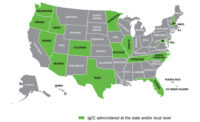...construction projects, and it will do it in a language and style that is familiar to them,” Armstrong says.
In the absence of formal green construction regulations, code officials in most jurisdictions are working within the context of existing conventional I-code-based building codes—including the ICC’s International Energy Conservation Code, which mandates energy-efficiency standards.
The new code aims to address some of the inconsistencies between the conventional codes and the green building standards encouraged by voluntary certification systems, including LEED, Green Globes, Energy Star and BREEM. One such case is the waterless urinal, prohibited under conventional code provisions in some jurisdictions yet widely used in green construction projects as a water-saving measure.
Selective Adoption Jurisdictions may adopt all or select only some regulations within the codebook, and as necessary, modify the regulations to meet their specific needs. Many of the regulations will be written to include tiered levels of compliance, allowing jurisdictions the option to choose a level appropriate for their needs. Jurisdictions in high-drought regions, for example, may opt for stricter water-saving regulations.
Such flexibility is a point of contention for some parties who fear that a code developed through consensus will put forth inadequate standards, according to Kent Peterson, chair of the Standard 189 committee.
IGCC’s Sustainable Building Technology Committee is conducting five open meetings to develop its draft. The first three meetings were held in July, August and October in Chicago, Denver and Philadelphia, respectively. The last two are scheduled for December in Fort Meyers, Fla., and January in Austin, Texas. For more information on the SBTC’s process, go to www.iccsafe.org/cs/IGCC/Pages/default.aspx.
“Allowing jurisdictions to pick their level of compliance and decide which regulations suit their whims—honestly, I think it’s a copout and a green wash,” Peterson says. “Green buildings must comply with minimum regulations in all of the key categories—not just one or two regulations here and there at whatever level they see fit.”
The timing of the initiative couldn’t be better, says Stephen Kanipe, Aspen’s chief building official and a member of the committee charged with drafting the new code.
“A number of states and municipalities have wanted to develop their own green construction codes, but with so many experiencing budget challenges and layoffs, few can allocate the resources and manpower to the process right now,” Kanipe says.
Denver and Fort Collins are among the jurisdictions in Colorado that have considered developing their own green construction codes and may benefit from ICC’s efforts. While both cities have encouraged green building and energy conservation through various programs, including Energy Star Colorado, neither has adopted a formal, comprehensive code that mandates green construction practices for commercial buildings.
Other countries may draw upon the new code as well, according to John Loyer, director of state relations for AIA. Sweden, Canada and South Africa are looking at the new code as a basis for developing their own national regulations.


Post a comment to this article
Report Abusive Comment